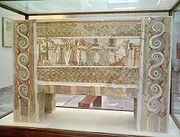
Hagia Triada sarcophagus
Encyclopedia

Bronze Age
The Bronze Age is a period characterized by the use of copper and its alloy bronze as the chief hard materials in the manufacture of some implements and weapons. Chronologically, it stands between the Stone Age and Iron Age...
137 cm-long limestone sarcophagus
Sarcophagus
A sarcophagus is a funeral receptacle for a corpse, most commonly carved or cut from stone. The word "sarcophagus" comes from the Greek σαρξ sarx meaning "flesh", and φαγειν phagein meaning "to eat", hence sarkophagus means "flesh-eating"; from the phrase lithos sarkophagos...
. It was originally dated to 1400 BC and was rediscovered in Hagia Triada
Hagia triada
Hagia Triada is the archaeological site of an ancient Minoan settlement. Hagia Triada is situated on a prominent coastal ridge, with the Mesara Plain below. Hagia triada sits at the western end of the ridge, while Phaistos is at the eastern end...
on Crete
Crete
Crete is the largest and most populous of the Greek islands, the fifth largest island in the Mediterranean Sea, and one of the thirteen administrative regions of Greece. It forms a significant part of the economy and cultural heritage of Greece while retaining its own local cultural traits...
in 1903. It provides probably the most comprehensive iconography of a pre-Homeric thysiastikis ceremony and one of the best pieces of information on noble burial customs when Crete was under Mycenaean
Mycenaean Greece
Mycenaean Greece was a cultural period of Bronze Age Greece taking its name from the archaeological site of Mycenae in northeastern Argolis, in the Peloponnese of southern Greece. Athens, Pylos, Thebes, and Tiryns are also important Mycenaean sites...
rule, combining features of Minoan
Minoan civilization
The Minoan civilization was a Bronze Age civilization that arose on the island of Crete and flourished from approximately the 27th century BC to the 15th century BC. It was rediscovered at the beginning of the 20th century through the work of the British archaeologist Arthur Evans...
and Mycenaean style and subject matter. It is on display in the Heraklion Archaeological Museum.
Description
Coated in plaster and painted in frescoFresco
Fresco is any of several related mural painting types, executed on plaster on walls or ceilings. The word fresco comes from the Greek word affresca which derives from the Latin word for "fresh". Frescoes first developed in the ancient world and continued to be popular through the Renaissance...
, it has posed an art historical conundrum ever since its rediscovery, since the Minoans (unlike the ancient Egypt
Ancient Egypt
Ancient Egypt was an ancient civilization of Northeastern Africa, concentrated along the lower reaches of the Nile River in what is now the modern country of Egypt. Egyptian civilization coalesced around 3150 BC with the political unification of Upper and Lower Egypt under the first pharaoh...
ians) otherwise only used frescoes for the enjoyment of the living and not in funerary practice. It is the only limestone sarcophagus of its era discovered to date and the only sarcophagus with a series of narrative scenes of Minoan funerary ritual (later sarcophagi found in the Aegean were decorated with abstract designs and patterns). It was originally used for the burial of a prince. The painted frieze around the sarcophagus shows all the stages of the sacred ceremony which was performed at the burial of important personages. In the centre of one of the long sides of the sarcophagus is a scene with bull sacrifice. On the left of the second long side a woman wearing a crown is carrying two vessels.By her side a man dressed in a long robe is playing a seven string lyre
Lyre
The lyre is a stringed musical instrument known for its use in Greek classical antiquity and later. The word comes from the Greek "λύρα" and the earliest reference to the word is the Mycenaean Greek ru-ra-ta-e, meaning "lyrists", written in Linear B syllabic script...
. This is the earliest picture of the lyre known in classical Greece. In front of them another woman is emptying the contents of a vessel-perhaps the blood of the sacrificed bull-into a second vessel, possibly as an invocation to the soul of the deceased.(This scene reminds us a description of Homer, where the dead needed blood). On the left three men holding animals and a boat are approaching a male figure without arms and legs and presumably he represents the dead man receiving gifts (the boat for his journey to the next world). It is possible that they believed that the dead was living in a different state and he could probably reappear.

